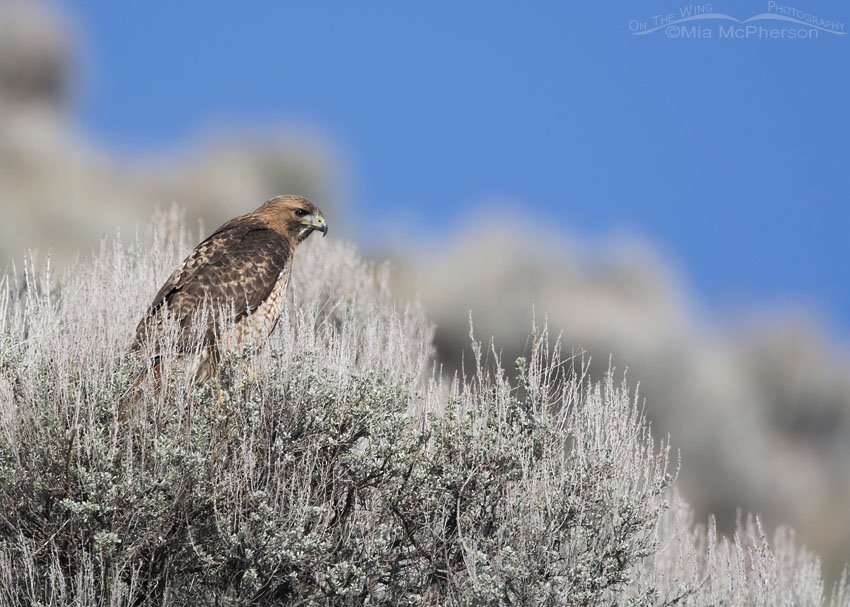 Adult Red-tailed Hawk perched on top of sagebrush – Nikon D500, f6.3, 1/1600, ISO 320, +0.3 EV, Nikkor 500mm VR with 1.4x TC, natural light
Adult Red-tailed Hawk perched on top of sagebrush – Nikon D500, f6.3, 1/1600, ISO 320, +0.3 EV, Nikkor 500mm VR with 1.4x TC, natural light
It is now the time of the year when the sagebrush begins to push forth new silver-green leaves and the aroma of the sage can tickle my senses simply by brushing it lightly with my hands. I know some people can’t stand the smell of sagebrush but I love it. The pungency of the scent revitalizes me in the early spring.
It is the time of year when Red-tailed Hawks begin to nest, by now most of them here in northern Utah have already selected a mate so they find a nesting location and start to collect nesting materials as the days grow longer and warmer.
This Red-tailed Hawk was perched on sagebrush near a nesting site one year ago today that has been used for several years now. The pair that used that nest last year successfully reared two young that fledged and I wonder if that nest will be used again and by the same pair of hawks. Time will tell I guess, maybe the same pair will nest there and maybe a new pair will take it over this spring.
I just hope that whoever nests there; if anyone does, is successful in rearing their young.
Life is good.
Mia
Red-tailed Hawk facts:
- Red-tailed Hawks can be found in every state in the U.S. except Hawaii and throughout most of Canada, Mexico and the Caribbean.
- They are hawks of open country, fields, deserts, mixed woodlands, grasslands, roadsides, pastures, range and agricultural areas and will perch and nest on man-made as well as natural objects.
- Red-tailed hawks are monogamous and may mate for life.
- Mated pairs will also hunt together.
- They lay 1 to 5 eggs which hatch in about 30 days. Both sexes incubate the eggs.
- Courting Red-tailed Hawks put on an aerial display that both sexes participate in.
- Red-tailed Hawks are known to have extremely variable plumage, some of that variability is due to geographical regions the Red-tailed Hawks are found in and some variation is because there are light, intermediate (rufous), and dark morphs including Harlan’s Hawks which are darker overall.
- Their diet includes small mammals including rabbits, jackrabbits, hares, mice, voles, ground squirrels, and rats. They will also consume upland game birds, passerines, lizards, snakes and carrion.
- Red-tailed Hawks used to be called Chicken Hawks.
- Red-tailed Hawks can live beyond 21 years.


Oooh. That sage is beautiful. A fitting stage for the red-tail. And how I wish I had smell-o-vision. Brushing up against scented leaves is an ongoing joy. And how I wish I could see these glorious birds for myself…
Well, you got me with two of my favorite things–redtails and sage. Both thrill me to my soul!
Of course, redtails just rock. We’re so very lucky to have such a versatile and gorgeous hawk on this continent as to be an embarrassment of riches
As for what they eat, either Sibly, Dunne or Sutton said in “Hawks in Flight,” “Any furred, feathered, or scaled creature that is smaller than a groundhog and turns its back on a meal-minded Red-tailed is very likely going to be returned to the earth as a pellet.” To me, this quote smacks of Dunne. And I’d quibble with the “smaller than a groundhog” part. I know of two redtails who took down coyotes. One was a small male, weighing 670 grams (if I remember correctly) that just cold cocked the coyote then went about the task of killing it while it was out! Obviously, that was an outlier and a falconry bird, but still! Mariah also successfully hunted ducks and pheasants, so almost nothing is out of their range. Again, redtails ROCK!
Speaking of nesting redtails, the Cornell female (Big Red) and her new young mate have started the hard incubation process with three eggs! YIPPEE!! If you’re interested in an up close and personal look at the Zen of Incubation (for the next 30-ish days) and the fuzzball bobbleheads (baby redtails) as they grow into fledging, you can find the Cornell University/Lab of Ornithology nest cam at http://cams.allaboutbirds.org/channel/16/Red-tailed_Hawks/
Looking forward to another good birding spring and summer.
Love the spikey silver sage and am, once again, reminded that the Red-tailed Hawk is the little brother of the Golden Eagle…
Patty, I agree with you 100%! I’m SO outrageously blessed to have lived with Mariah for the last 24 years. She’s taught me SO much, including don’t EVER say never (or always, too, for that matter). There’s a redtail out there who will prove you wrong, just for fun!